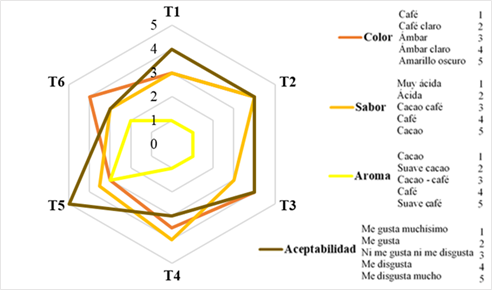Effect of different concentrations of cocoa (Theobroma cacao L.) and coffee (Coffea arabica) mucilage in the preparation of an energy drink
DOI:
https://doi.org/10.51252/raa.v4i1.600Keywords:
hydrating beverage, coffee, energy, mucilageAbstract
Cocoa mucilage is a very little industrialized by-product due to the lack of knowledge of its physicochemical properties and the lack of technological innovation for its handling and transformation. Therefore, the objective of this study was to evaluate the effect of different concentrations of cocoa and coffee mucilage in the preparation of an energy drink. A Completely Randomized Design (C.R.D.) was used, evaluating 6 treatments with three replications was used to determine statistical differences using a Tukey significance test (p<0.05). The different concentrations of cocoa and coffee mucilage had a significant influence on the physicochemical characteristics (pH, titratable acidity, °Brix, ash, moisture, protein, density and carbohydrates) of the beverage; also, the treatments had a high energy content (43.08kcal to 58.60kcal). In relation to the sensory characteristics, T5 = 20% cocoa mucilage pulp and 1% coffee, obtained a greater acceptance by the tasters with the category "I like it a lot", in addition, it presented an amber color, flavor and aroma with slight notes of cocoa-coffee. With this, it is concluded that cocoa mucilage can be an alternative in the energy drink market.
Downloads
References
Afolabi, O., Ibitoye, O., & Agbaje, F. (2015). Evaluation of Nutritional and Sensory Properties of Cocoa Pulp Beverage Supplemented with Pineapple Juice. Journal of Food Research, 4(6), 58. https://doi.org/10.5539/jfr.v4n6p58 DOI: https://doi.org/10.5539/jfr.v4n6p58
Alava Zambrano, W. A. (2020). Caracterización física – química del mucílago de cacao (Theobroma Cacao L.) Con énfasis en los azúcares que lo componen [Universidad Agraria Del Ecuador]. https://cia.uagraria.edu.ec/Archivos/ALAVA ZAMBRANO WISTON ADRIAN.pdf
Anvoh, K. Y. B., Bi, A. Z., & Gnakri, D. (2009). Production and Characterization of Juice from Mucilage of Cocoa Beans and its Transformation into Marmalade. Pakistan Journal of Nutrition, 8(2), 129–133. https://doi.org/10.3923/pjn.2009.129.133 DOI: https://doi.org/10.3923/pjn.2009.129.133
Arciniega-Alvarado, G. A., & Espinoza-León, R. A. (2020). Optimización de una bebida a base del Mucílago del Cacao (Theobroma cacao), como aprovechamiento de uno de sus subproductos. Dominio de Las Ciencias, 6(3), 310–326. https://dominiodelasciencias.com/ojs/index.php/es/article/view/1286
Balladares, C., Garca, J., ChezGuaranda, I., Prez, S., Gonzlez, J., Sosa, D., Viteri, R., Barragn, A., QuijanoAviles, M., & Manzano, P. (2016). Physicochemical characterization of Theobroma cacao L. mucilage, in Ecuadorian coast. Emirates Journal of Food and Agriculture, 28(10), 741. https://doi.org/10.9755/ejfa.2016-02-187 DOI: https://doi.org/10.9755/ejfa.2016-02-187
Barreda Abascal, R., Molina, L., Haro-Valencia, R., Alford, C., & Verster, J. C. (2012). Actualización sobre los efectos de lacafeina y su perfil de seguridad enalimentos y bebidas. Revista Médica Del Hospital General de México, 75(1), 60–67. https://www.elsevier.es/en-revista-revista-medica-del-hospital-general-325-pdf-X018510631223160X
Cabrera-Blanco, O., Patiño-Altafuya, J. E., Bazurto-García, D. L., & Cuello-Pérez, M. (2022). Obtención de vino y vinagre a partir del mucílago de cacao (Theobroma Cacao L.) CCN-51. Revista UTCiencia, 9(2). http://investigacion.utc.edu.ec/revistasutc/index.php/utciencia/article/view/457/523
Ciro Castro, E., & Virgüez Garzón, N. V. (2019). Evaluación del mucílago del caf aluación del mucílago del café (Coff é (Coffea arabica L. Caturr abica L. Caturra) como potencial prebiótico en una bebida de arroz [Universidad de La Salle]. https://ciencia.lasalle.edu.co/cgi/viewcontent.cgi?article=1277&context=ing_alimentos
Delgado-Noboa, J., Bernal, T., Soler, J., & Peña, J. Á. (2021). Kinetic modeling of batch bioethanol production from CCN-51 Cocoa Mucilage. Journal of the Taiwan Institute of Chemical Engineers, 128, 169–175. https://doi.org/10.1016/j.jtice.2021.08.040 DOI: https://doi.org/10.1016/j.jtice.2021.08.040
Escobar Auqui, C. C. (2023). Elaboración de un néctar a base del mucílago de cacao (Theobroma Cacao) [Universidad Técnica de Ambato]. https://repositorio.uta.edu.ec/jspui/handle/123456789/37885
INEN. (2008). Turismo, cocinero polivalente. Requisitos de competencia laboral (p. 10). Instituto Ecuatoriano de Normalización. https://www.qualiturecuador.com/contenidos/areas/normas_inen/INEN2441-08.pdf
Loor Vélez, Y. M., & Heredia Moyano, S. F. (2023). Aprovechamiento y evaluación de una bebida no alcohólica a base de mucílago y placenta de Theobroma cacao L, Ananas comosus y Mangifera indica. Revista InGenio, 6(1), 10–19. https://doi.org/10.18779/ingenio.v6i1.559 DOI: https://doi.org/10.18779/ingenio.v6i1.559
Manrique, C., Arroyave-Hoyos, C., & Galvis-Pareja, D. (2018). Bebidas cafeínadas energizantes: efectos neurológicos y cardiovasculares. IATREIA, 31(1), 65–75. https://doi.org/10.17533/udea.iatreia.v31n1a06
Manrique, C. I., Arroyave-Hoyos, C. L., & Galvis-Pareja, D. (2018). Bebidas cafeínadas energizantes: efectos neurológicos y cardiovasculares. IATREIA, 31(1), 65–75. https://doi.org/10.17533/udea.iatreia.v31n1a06 DOI: https://doi.org/10.17533/udea.iatreia.v31n1a06
Martínez, V. M., Aristizábal, I. D., & Moreno, E. L. (2017). Evaluation of the composition effect of harvested coffee in the organoleptic properties of coffee drink. Vitae, 24(1), 47–58. https://doi.org/10.17533/udea.vitae.v24n1a06 DOI: https://doi.org/10.17533/udea.vitae.v24n1a06
Morgan, P., Wollman, P., Jackman, S., & Bowtell, J. (2018). Flavanol-Rich Cacao Mucilage Juice Enhances Recovery of Power but Not Strength from Intensive Exercise in Healthy, Young Men. Sports, 6(4), 159. https://doi.org/10.3390/sports6040159 DOI: https://doi.org/10.3390/sports6040159
Muñoz Mendoza, G., Erazo Solórzano, C., Vera Chang, J., & Tuarez García, D. (2020). Bebida De Lactosuero Y Soya (Glycine Max) Inoculada Con Mucílago De Cacao (Theobroma Cacao L) Nacional. Universidad, Ciencia y Tecnología, 1, 44–52. https://docplayer.es/201762547-Bebida-de-lactosuero-y-soya-glycine-max-inoculada-con-mucilago-de-cacao-theobroma-cacao-l-nacional-recibido-08-05-20-aceptado-22-05-20.html
Murphy, M. (2020). GRAS Conclusion for the Use of Cacao Pulp, Juice and Concentrate in Select Foods. U.S. Food & Drug Administration. https://www.fda.gov/food/generally-recognized-safe-gras/gras-notice-inventory
Nguyen-Thi, T. T., Nguyen-Tien, A., H.-T, T., & Nguyen-Thi, T. (2016). A study of wine fermentation from mucilage of cocoa beans (Theobroma Cacao L.). Dalat University Journal of Science, 6(3), 387–397. https://doi.org/10.37569/DalatUniversity.6.3.83(2016) DOI: https://doi.org/10.37569/DalatUniversity.6.3.83(2016)
Oddoye, E. O. K., Agyente-Badu, C. K., & Gyedu-Akoto, E. (2013). Cocoa and Its By-Products: Identification and Utilization. In Chocolate in Health and Nutrition (pp. 23–37). Humana Press. https://doi.org/10.1007/978-1-61779-803-0_3 DOI: https://doi.org/10.1007/978-1-61779-803-0_3
OIML. (2011). Guía Oiml G – 14: Medición De Densidad (p. 34). Organización Internacional de Metrología Legal. https://www.oiml.org/en/publications/other-language-translations/spanish/g014-es11.pdf
Pacheco Uribe, D. Y. (2020). Obtención de una bebida alcohólica a partir del mucilago de cacao en finca del Urabá [Universidad Nacional Abierta y a Distancia]. https://repository.unad.edu.co/handle/10596/39032
Pájaro-Escobar, H. A., Benedetti, J., & García-Zapateiro, L. A. (2018). Caracterización Fisicoquímica y Microbiológica de un Vino de Frutas a base de Tamarindo ( Tamarindus indica L. ) y Carambola ( Averrhoa carambola L. ). Información Tecnológica, 29(5), 123–130. https://doi.org/10.4067/S0718-07642018000500123 DOI: https://doi.org/10.4067/S0718-07642018000500123
Rivera Cepeda, S. B. (2019). Propuesta de aplicación del mucílago de cacao para la elaboración de bebidas y postres mediante técnicas de vanguardia [Universidad de Cuenca]. http://dspace.ucuenca.edu.ec/handle/123456789/33415
Rodríguez Castro, R., Posada Izquierdo, G., Valero Díaz, A., Torres Navarrete, E., Torres Navarrete, Y., & Díaz Ocampo, R. (2021). Valoración de baba de cacao (mucílago) no utilizada en el cantón Quevedo - Ecuador. Revista Científica Ciencia y Tecnología, 21(32), 79–86. https://doi.org/10.47189/rcct.v21i32.489 DOI: https://doi.org/10.47189/rcct.v21i32.489
Sánchez-Olaya, D. M., Rodriguez Perez, W., Castro Rojas, D. F., & Trujillo Trujillo, E. (2019). Respuesta agronómica de mucilago de cacao (Theobroma cacao L.) en cultivo de maíz (Zea mays L.). Ciencia En Desarrollo, 10(2), 43–58. https://doi.org/10.19053/01217488.v10.n2.2019.7958 DOI: https://doi.org/10.19053/01217488.v10.n2.2019.7958
Sánchez Maroto, M. (2015). El café, la cafeína y su relación con la salud y ciertas patologías [Universidad de Valladolid]. http://uvadoc.uva.es/handle/10324/14253
Santana, P., Vera, J., Vallejo, C., & Alvarez, A. (2017). Mucílago de Cacao, nacional y trinitario para la obtención de una bebida hidratante. Universidad, Ciencia Y Tecnología, 4, 179–189. https://uctunexpo.autanabooks.com/index.php/uct/article/view/24
Santana, P., Vera, J., Vallejo, C., & Álvarez, A. (2019). Mucílago de cacao, nacional y trinitario para la obtención de una bebida hidratante. Universidad Ciencia Y Tecnología, 4. https://uctunexpo.autanabooks.com/index.php/uct/article/view/24
Soares, T. F., & Oliveira, M. B. P. P. (2022). Cocoa By-Products: Characterization of Bioactive Compounds and Beneficial Health Effects. Molecules, 27(5), 1625. https://doi.org/10.3390/molecules27051625 DOI: https://doi.org/10.3390/molecules27051625
Ticsihua Huaman, J., & Orejon Montalvo, T. Y. (2022). Evaluación del efecto de concentración en una bebida funcional a partir de tuna blanca (Opuntia ficus) y aguaymanto (Physalis peruviana). Revista Alfa, 6(18), 383–392. https://doi.org/10.33996/revistaalfa.v6i18.175 DOI: https://doi.org/10.33996/revistaalfa.v6i18.175
Valencia Farro, A. E., & Zambrano Muñoz, R. J. (2021). Caracterización fisicoquímica de una bebida de avena (Avena sativa) con adición de mucilago de cacao (Theobroma cacao L.) [Universidad Técnica de Manabí]. http://repositorio.utm.edu.ec/handle/123456789/1784
Vallejo Torres, C. A., Díaz Ocampo, R., Morales Rodríguez, W., Soria Velasco, R., Vera Chang, J. F., & Baren Cedeño, C. (2016). Utilización del mucílago de cacao, tipo nacional y trinitario, en la obtención de jalea. Revista ESPAMCIENCIA, 7(1), 51–58. http://revistasespam.espam.edu.ec/index.php/Revista_ESPAMCIENCIA/article/view/116
Vega, A., De León, J. A., Reyes, S. M., & Miranda, S. Y. (2018). Componentes Bioactivos de Diferentes Marcas de Café Comerciales de Panamá. Relación entre Ácidos Clorogénicos y Cafeína. Información Tecnológica, 29(4), 43–54. https://doi.org/10.4067/S0718-07642018000400043 DOI: https://doi.org/10.4067/S0718-07642018000400043
Villarroel Bastidas, J., Badillo Melo, W. A., & Briones Bitar, J. (2022). Sustainability of the Cocoa Industry: Cocoa Waste Mucilage Use to Produce Fermented Beverages. Case Study in Los Ríos Province. International Journal of Sustainable Development & Planning, 17(4), 1147–1152. https://doi.org/10.18280/ijsdp.170412 DOI: https://doi.org/10.18280/ijsdp.170412

Published
How to Cite
Issue
Section
License
Copyright (c) 2024 Sindy Paola López-Narváez, Gina Mariuxi Guapi-Alava, Vicente Alberto Guerrón-Troya, Karol Yannela Revilla-Escobar, Jhonnatan Placido Aldas-Morejon, Sonnia Esther Barzola-Miranda

This work is licensed under a Creative Commons Attribution 4.0 International License.
The authors retain their rights:
a. The authors retain their trademark and patent rights, as well as any process or procedure described in the article.
b. The authors retain the right to share, copy, distribute, execute and publicly communicate the article published in the Revista Agrotecnológica Amazónica (RAA) (for example, place it in an institutional repository or publish it in a book), with an acknowledgment of its initial publication in the RAA.
c. Authors retain the right to make a subsequent publication of their work, to use the article or any part of it (for example: a compilation of their works, notes for conferences, thesis, or for a book), provided that they indicate the source of publication (authors of the work, journal, volume, number and date).











